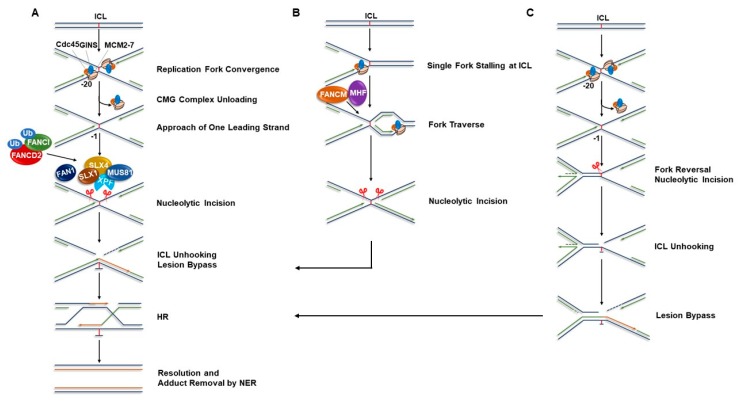Figure 1.
Models of replication-coupled ICL repair. In replicating cells, ICLs are efficiently repaired by cooperative action of FA pathway proteins and the proteins involved in the NER, TLS, and HR pathways. Other than the classical ICL repair model of single fork convergence, there are different proposed mechanisms by which crosslinks can be repaired in a replication-dependent manner, enabling forks stalled at ICLs to resume DNA synthesis. (A) Dual fork convergence model. Crosslink repair is triggered when two replication forks converge at an ICL. The leading strands of two converging forks initially stall at ~20 nucleotides away from the lesion due to the steric hindrance imposed by the CMG complex (Cdc45/MCM2-7/GINS). Ubiquitin signaling promotes chromatin unloading of the CMG complex, which allows one of the leading strands on either side of the ICL to approach to within one nucleotide of the lesion. The FA pathway is simultaneously activated through the monoubiquitination of the FANCI‒FANCD2 complex. Ubiquitylated FANCI‒FANCD2 in turn promotes recruitment of SLX4 (FANCP), which acts as a molecular scaffold to recruit structure-specific endonucleases SLX1, XPF (FANCQ)-ERCC1, and MUS81 at the ICL site. Nucleolytic incision and subsequent unhooking of the ICL by the coordinated actions of these enzymes creates a DSB in one sister chromatid. FAN1, another endonuclease, is also implicated in the incision step. TLS polymerases, Pol ζ and REV1 subsequently extend the leading strand past the unhooked ICL and generate an intact DNA template suitable for HR repair. The DSB is finally repaired by HR and the unhooked ICL is removed by NER process. (B) Replication traverse model. In living cells, the majority (~60%) of replication forks encountering ICLs bypass the lesions without unhooking them in a manner dependent on the translocase activity of FANCM/MHF complex. The “X-shaped” DNA structures generated through the traverse process are subsequently processed by endonucleases followed by lesion bypass and post-replication repair as in dual fork convergence model. (C) Replication fork reversal at ICL. Following CMG complex unloading, one of the two converging forks undergoes reversal. The opposite fork is subsequently incised by the endonucleases leading to ICL unhooking. The lesion is then bypassed by the action of TLS polymerases and DSB intermediate generated during the incision process is finally repaired by HR. ICL: Interstrand cross-link; FA: Fanconi anemia; NER: Nucleotide excision repair; TLS: Translesion; HR: Homologous recombination.

